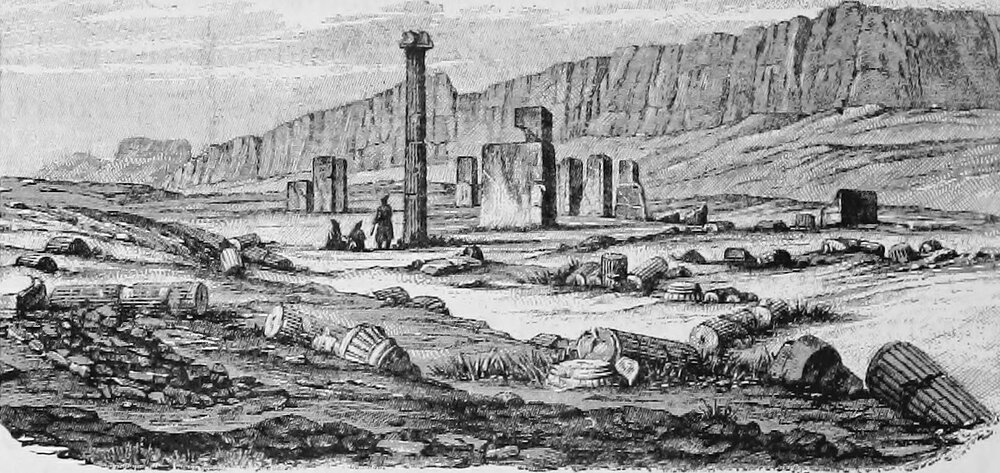Istakhr, once legendary residence of Persian kings

TEHRAN – The ancient city of Istakhr was the seat of local governments and a royal residence of Persian kings during the Sassanid era. Moreover, it acquired importance as a center of priestly wisdom and orthodoxy.
Istakhr rose to fame when Ardashir I, the founder of the Sasanian Empire, chose it as his residence in 224 CE when the Persian nobleman dethroned a lawful ruler in Persia, Artabanus IV, king of the Parthian Empire.
Situated near the legendary Persepolis, which was once the ceremonial capital of the Achaemenids, Istakhr allowed the new Sasanian dynasty to identify itself with a glorious past. The builders of Istakhr often reused architectural elements from the monuments of Persepolis. The Achaemenid royal tombs of Naqsh-e Rostam are not far from Istakhr too.
However, the city itself was not completely new: human occupation had started as early as the fourth millennium BC, and the site was certainly occupied in the Bronze Age, by the Achaemenids, by the Seleucids (who used it as a mint town), and by the Parthians, according to livius.org.
The city, which had strong walls, repulsed the first Arab attack in c.644, but was captured and sacked in c.650. Although the site was not abandoned, most people moved to Shiraz (which was founded in 684). Once, as an Islamic town, it was enclosed by fortification walls with rounded towers.
Today, Istakhr is nothing but a plain full of sherds, scattered architectural remains, and a few ruins. The walled-in area measured 1,400 by 650 meters and was surrounded by a ditch that was connected to a nearby river.
The Sassanid era (224 CE–651) is of very high importance in the history of Iran. Under Sassanids, Persian art and architecture experienced a general renaissance. Architecture often took grandiose proportions such as palaces at Ctesiphon, Firuzabad, and Sarvestan that are amongst highlights of the ensemble.
Istakhr remained popular after the fall of Sassanids by Arab innovators. According to the Oriental Institute of the University of Chicago, the geographer Istakhri wrote that in the tenth century, its houses were built of clay, stone, or gypsum according to the wealth of their owners.
Furthermore, Istakhr has yielded many magnificent relics so far. An ancient trash pit at Istakhr proved to be a very valuable source of finds. According to archaeological sources, the entire site is perforated by several sewage or storage wellholes. The holes are often “locked” by caps of brick or stone, and therefore an approximately contemporaneous mixture of broken and discarded pots, personal ornaments, stone and bronze objects, and a large number of coins was preserved in them.
Among the kinds of pottery being unearthed from the Islamic [archaeological] layers, molded ware is found very frequently. These light-green vessels were not only of very high quality but also manifested a unique method of pottery making. The upper and lower halves, with their sculptured decorations, were always molded separately; the two halves, often showing the same pattern, were then joined together.
Unfortunately, excavations of the site produced only a few of the famous and very rare lusterware vessels with their metallic sheen over a golden-yellowish body. Also from the Islamic period, but less frequent, are pitchers with floral designs in red, yellow, and black. There is considerable controversy about this pottery and whether it was produced in Iran or imported from Mesopotamia.
There were also stone and bronze objects, such as lamps, small vessels, and some utensils used in daily life. Also found were objects of iridescent glass and personal ornaments ranging from clay to gold. Among other finds were clay figurines of animals.
Under the Sasanians, Iranian art experienced a general renaissance. Architecture often took grandiose proportions, such as the palaces at Ctesiphon, Firouzabad, and Saravan. Amongst the most characteristic and striking relics of the Sassanids are rock sculptures carved on abrupt limestone cliffs, for example at Shapur (Bishapour), Naqsh-e Rostam, and Naqsh-e Rajab. Metalwork and gem engraving became highly sophisticated. The Sassanid archaeological landscape also represents a highly efficient system of land use and strategic utilization of natural topography in the creation of the earliest cultural centers of the Sassanid civilization. Crafts such as metalwork and gem-engraving grew highly sophisticated, yet scholarship was encouraged by the state. In those years, works from both the East and West were translated into Pahlavi, the language of the Sassanians.
In 2018, UNESCO added an ensemble of Sassanian historical cities in southern Iran -- titled “Sassanid Archaeological Landscape of Fars Region”-- to its World Heritage list. The ensemble is comprised of eight archaeological sites situated in three geographical parts of Firuzabad, Bishapur, and Sarvestan. The World Heritage reflects the optimized utilization of natural topography and bears witness to the influence of Achaemenid and Parthian cultural traditions and of Roman art, which later had a significant impact on the architecture and artistic styles of the Islamic era.
AFM

Leave a Comment